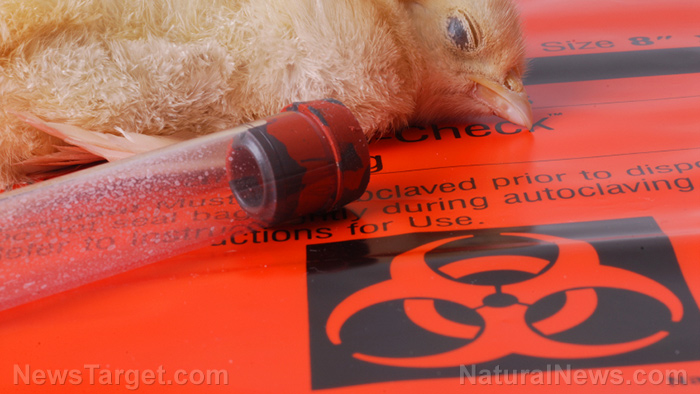Consumer Reports reveals certain food items carry high risk of PESTICIDE contamination
05/13/2024 / By Olivia Cook

Consumer Reports (CR) has unveiled alarming findings indicating that one out of every five tested foods available in the United States carries a high risk of pesticide contamination. The report, released on April 18, highlighted the presence of banned pesticides in certain foods, with green peas being cited as an example.
To assess the current state of affairs, CR conducted its most extensive review yet on pesticide levels in food. The analysis, based on seven years of data from the U.S. Department of Agriculture (USDA), scrutinized a variety of produce – both conventional and organically grown, domestically or imported to the United States. The study encompassed 59 common fruits and vegetables, examining not only fresh varieties but also canned, dried or frozen alternatives.
Pesticide contamination posed significant risks in 20 percent of the foods surveyed, including popular choices like bell peppers, blueberries, green beans, potatoes and strawberries.
Notably, green beans were found to contain residues of a pesticide banned for use on the vegetable in the U.S. for over a decade. Imported produce, particularly from Mexico, showed a higher likelihood of carrying hazardous levels of pesticide residues.
Dr. James E. Rogers, CR’s director of food safety research, expressed concern over the recurring pattern observed. He described it as a case of progress followed by setbacks in pesticide regulation.
According to Rogers, this concentrated risk facilitates targeted solutions, albeit requiring concerted efforts and time to prompt regulatory adjustments by the Environmental Protection Agency (EPA), which is responsible for overseeing pesticide use in agriculture.
Despite the concerning findings, the report also offered some reassurance. Nearly two-thirds of the foods tested, including the majority of organic options, exhibited minimal pesticide risks. Furthermore, the analysis revealed that the greatest threats stemmed from a select few pesticides, primarily affecting specific foods cultivated on a small portion of U.S. farmland.
Health risks of pesticide use
Decades of research underscore a clear correlation between pesticide use and long-term adverse health effects in humans. Studies reveal a range of detrimental impacts across various bodily systems:
Cancer risk
Certain pesticides, including organochlorines, creosote and sulfamate, were identified as carcinogenic, while others, like DDT, chlordane and lindane were implicated in tumor growth. Arsenic, present in many pesticides, was also recognized as a human carcinogen.
Research published in Cancer Causes and Control, Environmental Health Perspectives and Reviews on Environmental Health suggested an increased risk of liver cancer, lung cancer and prostate cancers associated with pesticide exposure.
Respiratory issues
Individuals regularly exposed to pesticides, particularly through occupational use, face elevated risks of respiratory ailments, such as asthma, chronic bronchitis and impaired lung function. Studies also suggest a potential link between pesticide exposure and lung cancer.
Kidney damage
Investigations into chronic kidney disease reveal a positive association with pesticide exposure in a majority of studies, although conclusive findings are hindered by confounding factors and limited lifetime exposure assessments.
Neurological effects
Pesticides exert toxic effects on the nervous system, leading to cognitive decline and potentially increasing the risk of Parkinson’s disease. Research from the University of Guelph suggested a significant risk increase for Parkinson’s disease following exposure to specific pesticides.
Birth defects
High pesticide exposure, as indicated by a study in Nature Communications, correlated with elevated rates of birth defects – emphasizing the severe consequences of such exposure during pregnancy.
Endocrine disruption
Pesticides act as endocrine-disrupting chemicals, interfering with hormonal function and posing risks to sexual and reproductive health. Studies highlighted associations with childhood cancers, fetal death, infertility and low birth weight. (Related: Pesticide linked to reproductive issues found in popular oat-based breakfast cereals.)
Autism risk
Research published in BMJ suggested a heightened risk of autism spectrum disorders associated with prenatal pesticide exposure. Proximity to pesticide-treated fields during pregnancy is linked to increased autism risk and other neurodevelopmental disorders.
Environmental consequences of pesticide use
The ramifications of pesticide use extend beyond human health, profoundly impacting the environment in more ways than one:
Threat to pollinators
Pesticides pose a significant threat to vital pollinators like honey bees, disrupting their ability to collect pollen and negatively affecting their population. Chemicals, such as neonicotinoids – recognized for their toxicity to insect brains – are particularly harmful. Additionally, fungicides can disrupt bee gut bacteria and impede nutrient absorption from pollen.
Disruption of ecosystems
Excessive pesticide application leads to displacement of aquatic life, habitat destruction and insect mortality. Certain chemicals can render vegetation toxic to wildlife – disrupting the food chain and essential ecosystems.
Soil degradation
Pesticides degrade soil quality – diminishing essential nutrients, like nitrogen and potassium. This degradation not only affects soil-dwelling organisms, such as earthworms, frogs, snails and snakes but also compromises crop sustainability and reduces the nutritional value of food grown in contaminated soil.
Water contamination
Pesticides persist in the environment – contaminating water sources through erosion, leaching, microbial assimilation, plant absorption and runoff. This contamination poses risks to aquatic life and human health.
Risks to farm workers
Despite evidence suggesting the toxicity of even minimal pesticide exposure to humans, farm workers face significant health risks due to their regular and direct contact with these chemicals. The lack of routine health monitoring by regulatory agencies leaves farm workers vulnerable to higher exposure levels. Moreover, residues carried home on clothing and footwear inadvertently expose families to harmful chemicals.
Guidelines for minimizing pesticide exposure
Recent evidence underscores the detrimental health effects of even minimal chemical exposure, with approximately 90 percent of Americans harboring pesticides in their bodies. Environmental Working Group (EWG) tests reveal that around 70 percent of U.S. produce contains pesticide residues.
To reduce exposure to pesticides, experts recommend the following strategies:
Opt for organic
Choose organically grown foods or consider cultivating your own produce. Organic options, indicated by the USDA Organic seal, are cultivated without synthetic pesticides. While organic produce may still contain some pesticides, the use of synthetic chemicals is significantly lower compared to conventional farming practices. (Related: Avoid harmful chemicals like glyphosate in food by ALWAYS choosing ORGANIC.)
Mind the Dirty Dozen
Refer to the Environmental Working Group’s annual list of the “Dirty Dozen” and “Clean 15” to prioritize organic purchases. Items on the Dirty Dozen, such as spinach and strawberries, are known to contain higher pesticide residues and may warrant organic sourcing.
Thoroughly wash produce
Employ effective washing techniques to remove surface pesticide residues. Solutions, such as a 10 percent salt-water solution, full-strength vinegar or a baking soda-water mixture can help reduce surface chemicals. While washing may not eliminate pesticides absorbed into the produce, it can mitigate surface contamination.
Limit non-organic animal products
Reduce consumption of non-organic meat and dairy products, which may harbor pesticide residues from animal exposure to contaminated environments and feed. Studies have detected various pesticides in dairy products, highlighting the potential for environmental contamination.
Install home water filtration
Address potential pesticide contamination in drinking water by installing a home water filtration system. Such systems can effectively remove unwanted substances, enhancing water safety.
Explore natural pest control methods
Consider natural alternatives to chemical pesticides for gardening purposes. Homemade pesticides, beneficial insects and companion planting techniques can help manage pests without harming the environment.
Visit Pesticides.news for related stories.
Watch this video about washing pesticides off vegetables.
This video is from the Cheri and Timothy McGffin II channel on Brighteon.com.
More related stories:
Study finds popular pesticide could be behind rise in erectile dysfunction among young men.
Common herbicides linked to diminished brain function in young adults.
Sources include:
Submit a correction >>
Tagged Under:
carbamates, chemical violence, chemicals, clean food watch, food safety, food supply, fungicides, glyphosate, grocery, herbicides, home gardening, insecticides, neonicotinoids, Organic, organochlorines, organophosphates, paraquat, pyrethroids, toxic chemicals, toxins
This article may contain statements that reflect the opinion of the author
RECENT NEWS & ARTICLES
OrganicFarming.News is a fact-based public education website published by Organic Farming News Features, LLC.
All content copyright © 2018 by Organic Farming News Features, LLC.
Contact Us with Tips or Corrections
All trademarks, registered trademarks and servicemarks mentioned on this site are the property of their respective owners.



















